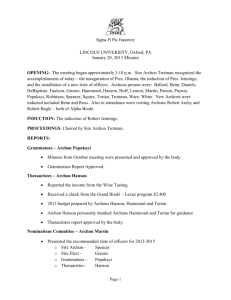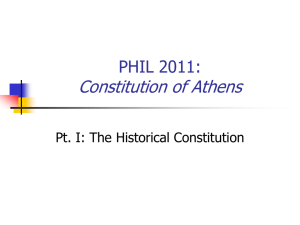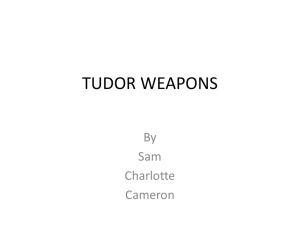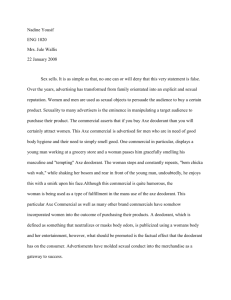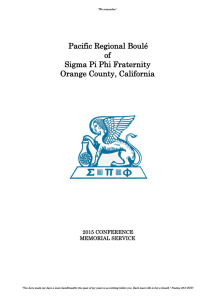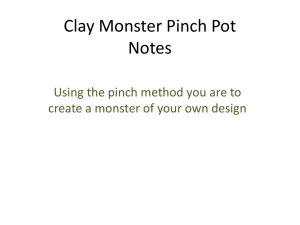Style Guide For Alliterative Amusements
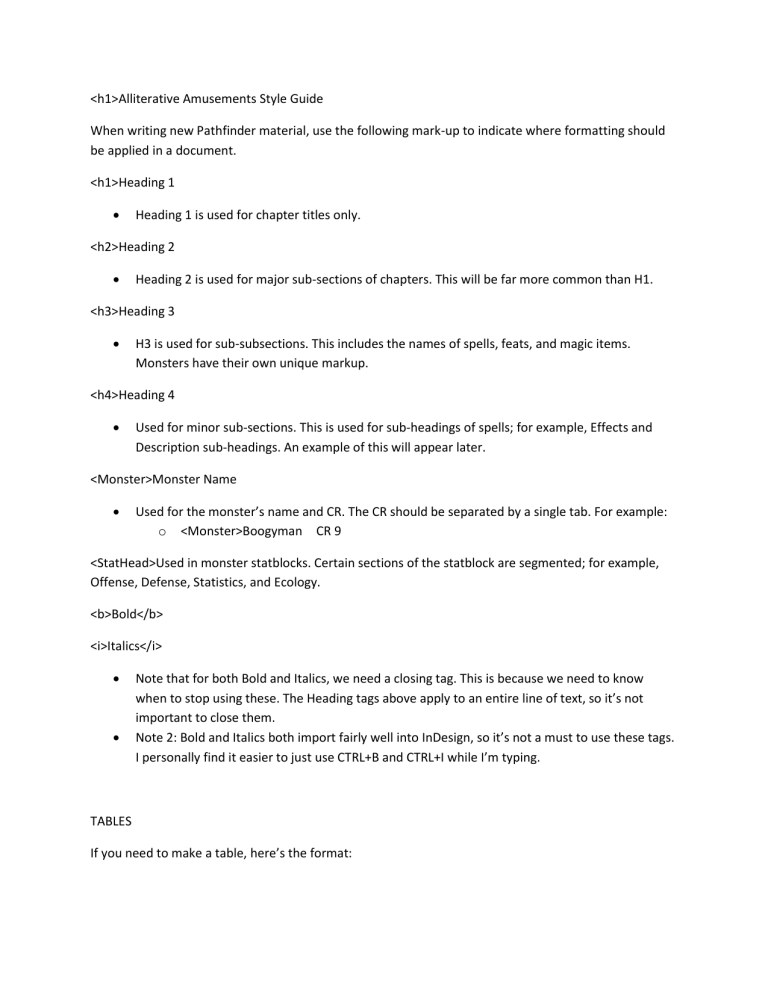
<h1>Alliterative Amusements Style Guide
When writing new Pathfinder material, use the following mark-up to indicate where formatting should be applied in a document.
<h1>Heading 1
Heading 1 is used for chapter titles only.
<h2>Heading 2
Heading 2 is used for major sub-sections of chapters. This will be far more common than H1.
<h3>Heading 3
H3 is used for sub-subsections. This includes the names of spells, feats, and magic items.
Monsters have their own unique markup.
<h4>Heading 4
Used for minor sub-sections. This is used for sub-headings of spells; for example, Effects and
Description sub-headings. An example of this will appear later.
<Monster>Monster Name
Used for the monster’s name and CR. The CR should be separated by a single tab. For example: o <Monster>Boogyman CR 9
<StatHead>Used in monster statblocks. Certain sections of the statblock are segmented; for example,
Offense, Defense, Statistics, and Ecology.
<b>Bold</b>
<i>Italics</i>
Note that for both Bold and Italics, we need a closing tag. This is because we need to know when to stop using these. The Heading tags above apply to an entire line of text, so it’s not important to close them.
Note 2: Bold and Italics both import fairly well into InDesign, so it’s not a must to use these tags.
I personally find it easier to just use CTRL+B and CTRL+I while I’m typing.
TABLES
If you need to make a table, here’s the format:
<table>
<thead>Table Title (e.g., Table: Muffin Varieties)
ColumnTitleA ColumnTitleB ClumnTitleC
EntryA EntryB EntryC
Entry1 Entry2 Entry3
</table>
Each entry in the table should be separated by a single tab and each new row should be made using a single return. The table is going to look a bit disjointed because things won’t always line up, but that’s okay.
SIDEBARS and BOX TEXT
I don’t’ use these much, but just in case:
<sidebar>
Info to go in sidebar.
</sidebar>
Or…
<box>
Info to go in box.
</box>
IMAGES
If you think an image would fit particularly well, feel free to leave an image tag and a short description.
These PDFs are going to be pretty art-light, but it’ll help me figure out where things should go and what they should look like if I can acquire the art to use.
<img>Image of a dragon swallowing a Halfling</img>
WHEN TO USE CAPS, BOLD, AND ITALICS
I try to stay consistent with Paizo’s formatting for feat names, skill names, spell names, etc. Feat names and skill names are always capitalized, spell names are always italicized. Race names are only capitalized at the beginning of a sentence, so it’s “orcs” not “Orcs.”
I’m sure I’m forgetting something. When in doubt, check how the core book writes/displays something.
SPECIFIC EXAMPLES – SPELL ENTRIES
Here’s an example of how a spell entry should be formatted:
<h3>Protection from Puddings
<b>School</b> abjuration; <b>Level</b> bard 1, cleric 1, druid 1, paladin 1, ranger 1, sorcerer/wizard 1
<h4>Casting
<b>Casting Time</b> 1 standard action
<b>Components</b> V, S, M/DF
<h4>Effect
<b>Range</b> touch
<b>Target</b> creature touched
<b>Duration</b> 1 min./level (D)
<b>Saving Throw</b> Will negates (harmless); <b>Spell Resistance</b> no
<h4>Description
This spell wards a creature from attacks by oozes. It creates a magical barrier around the subject…
Note that Paizo doesn’t use colons to separate descriptors from data (such as <b>Saving Throw</b> Will negates;) so I don’t either.
MONSTER ENTRY
Monster entries are huge. I usually copy/paste one entry, then replace bits of text as necessary (I do that for spells too, actually). Of course, not every monster has every type of ability so it makes things a little tricky. I try to style my entries as close to Paizo’s as possible, since it’s what people are most familiar with reading.
<monster>Axe Archon CR 9
If mirror archons are the judge and jury, axe archons are the executioners. Tasked with carrying out the sentences of mirror archons, these large celestials are designed to take out a single target as quickly as possible.
XP 9,600
LG Large outsider (archon, extraplanar, good, lawful)
Init +4; Senses darkvision 60 ft, low-light vision.; Perception +14
Aura aura of menace (DC 19), magic circle against evil
<StatHead>Defense
AC 25, touch 13, flat-footed 121 (+5 armor, +4 Dex, +7 natural, -1 size) (+2 deflection vs. evil)
hp 90 (10d10+30) (note how hp isn’t capitalized; I think it’s a little weird, but whatever)
Fort +10, Ref +11, Will +7; +4 vs. poison, +2 resistance vs. evil
DR: 10/evil; Immune electricity, petrification; SR 20
<StatHead>Offense
Speed 30 ft., fly 60 ft. (average)
Melee +1 holy greataxe +16/+11 (3d6+10); +18/+13 (3d6+12 plus 2d6 holy) vs. evil; or 2 slams
+15 (1d8+6)
Space 10 ft., Reach 10 ft.
Spell-Like Abilities (CL 10, Cha-based; Concentration +14)
Constant— magic circle against evil
At Will—aid, divine favor, greater teleport (self plus 50 lbs. of objects only), plane shift (self plus
50 lbs. of objects only)
<StatHead>Statistics
Str 22, Dex 18, Con 16, Int 10, Wis 19, Cha 10
Base Attk +10 CMB +17; CMD 31
Feats Ability Focus (aura of menace), Awesome Blow, Combat Reflexes, Power Attack, Step Up
Skills Acrobatics +17, Fly +17, Intimidate +13, Knowledge (the planes) +13, Perception +17,
Survival +17
Languages Celestial, Infernal; truespeech
<StatHead>Special Abilities
Execute (Ex) Axe archons deliver killing blows with surprising alacrity. They may deliver a coup de grace as a Standard action that does not provoke an attack of opportunity.
Imposing (Ex) Creatures affected by an axe archon’s aura of menace remain affected even if they successfully hit the archon in combat. When an axe archon successfully hits a creature affected by its aura of menace the axe archon gains a free Intimidate check with a +4 bonus.
Designated Target (Su) Each axe archon has a single target he is assigned to execute and will track that target across planes if necessary. Axe archons always know on which plane their target currently exists, and gain a +10 bonus on Survival checks to track a target when they are on the same plane. Additionally, axe archons gain a +2 sacred bonus on attacks, AC, saves, skills, and ability checks against that foe. An axe archon’s designated target only changes once one target has been mortally defeated.
<StatHead>Ecology
Environment any (Heaven)
Organization solitary, pair or squad (3 – 5 axe archons)
Treasure standard
Axe archons are large, imposing figures with black heads atop pearlescent winged bodies.
These forces of Heaven live to carry out the orders of their more judgmental counterparts, the mirror archons. They are rarely called upon to fight for any cause other than to execute those guilty of heinous crimes. If you have the misfortune of encountering an axe archon, beware the wrath of Heaven.
<StatHead>Lore
Characters with ranks in Knowledge (the planes) can learn more about axe archons. When a character makes a successful skill check, the following lore is revealed, including the information from lower DCs.
DC 19 Woe be it to the one the black-headed axe archon is after; this imposing figure exists only to execute those found guilty of heinous crimes. This result reveals all outsider and archon traits.
DC 24 Axe archons are even more menacing than their brethren and execute helpless foes with surprising speed that belies their large size.
DC 29 Axe archons are well within their boundaries as Heaven’s executioners to eliminate anyone assisting their designated target.
<StatHead>Binding
Axe archons almost never act of their own volition and are therefore very difficult to bind. They cannot be bartered with unless the binder’s goals are completely aligned with those of the axe archon; that is, if the binder intends to also eliminate the axe archon’s designated target.
I simply bolded the bold parts, above. It’s a lot easier that way.
CONTENT
What I’m looking for in these books:
In the magic books (Abjurer’s Appendix, Conjuror’s Compendium, etc.) I’m looking for at least one spell of each level and one new wizard subschool. Ideally, a short description of what the magic school is/does would be included. I’ve actually just lifted the descriptions from the PRD for quick reference and expounded when necessary / when I could think of something to add.
Anything else you can think to include would be great. Feats? Magic items that fit the theme
(such as a staff or something)? Added bonuses.
For the monster books, I’d really like to go into some detail about what they’re like and how they fit into a game. I’m really looking to add something to traditional Ecology sections that makes the GM say
“Wow, I can picture using that now.”
For the archons, I included:
Archons in Your Game o *Archons as Allies o Archons as Adversaries
New Archons (I could only think of 3 for these, but as many new types of monsters as you can think of would be ideal) o Lore: what does the player get with a Knowledge check? o Binding: how does one use planar ally to summon and bind one of these creatures?
For the goblins, which are more social, Included things like Goblin Society, Goblin Ecology, Goblin
Biology/Physiology, etc.
I also included lots of new goblins and goblin-related monsters
I also included a sample encounter (with XP chart) to help GMs out
Oh, and I also included one “named” NPC for each goblin type; basically I converted some old
PCs into goblins and gave them sufficiently high levels to be a challenge
For other books? I don’t know. I haven’t gotten that far yet.
